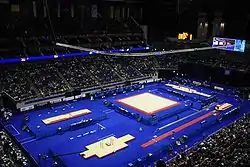Gymnastics at the 2012 Summer Olympics – Men's pommel horse
The men's pommel horse in artistic gymnastics at the 2012 Olympic Games in London was held at the North Greenwich Arena on 28 July and 5 August.[1] There were 69 competitors from 32 nations.[2] Krisztián Berki from Hungary won the gold medal. It was Hungary's first victory in the pommel horse since 1988 and fifth overall, tying the Soviet Union for most all-time. Great Britain's Louis Smith and Max Whitlock won silver and bronze respectively. Smith, who had won bronze in 2008, was the 10th man to win multiple medals in the event. It was the first time since 1984 that one nation earned multiple medals in the pommel horse.
| Men's pommel horse at the Games of the XXX Olympiad | ||||||||||
|---|---|---|---|---|---|---|---|---|---|---|
.jpg.webp) Ovidiu Buidoso on the pommel horse in the qualifying round | ||||||||||
| Venue | The O2 Arena | |||||||||
| Dates | 28 July (qualifying) 5 August (final) | |||||||||
| Competitors | 69 from 32 nations | |||||||||
| Winning score | 16.066 | |||||||||
| Medalists | ||||||||||
| ||||||||||
| Gymnastics at the 2012 Summer Olympics | ||
|---|---|---|
| List of gymnasts Qualification | ||
| Artistic | ||
| Qualification | men | women |
| Team all-around | men | women |
| Individual all-around | men | women |
| Vault | men | women |
| Floor | men | women |
| Pommel horse | men | |
| Rings | men | |
| Parallel bars | men | |
| Horizontal bar | men | |
| Uneven bars | women | |
| Balance beam | women | |
| Rhythmic | ||
| Group all-around | women | |
| Individual all-around | women | |
| Trampoline | ||
| Individual | men | women |
Background
This was the 23rd appearance of the event, which is one of the five apparatus events held every time there were apparatus events at the Summer Olympics (no apparatus events were held in 1900, 1908, 1912, or 1920). Three of the eight finalists from 2008 returned: silver medalist Filip Ude of Croatia, bronze medalist Louis Smith of Great Britain, and sixth-place finisher Kim Ji-Hoon of South Korea. Krisztián Berki of Hungary had won the last two world championships, in 2010 and 2011, and was favored in the event. Challengers included Smith (who had medaled at both of those world championships) and Cyril Tommasone of France (runner-up at 2011 worlds).[2]
Azerbaijan, Hong Kong, and Lithuania each made their debut in the men's pommel horse. The United States made its 21st appearance, most of any nation; the Americans had missed only the inaugural 1896 pommel horse and the boycotted 1980 Games.
Qualification
Qualification for the men's artistic gymnastics in 2008 was based primarily on the 2011 World Artistic Gymnastics Championships. The top 8 teams at the world championships could send a full team of 5 gymnasts to the Olympics. The next 8 teams (#9 through #16) competed in the 2012 Gymnastics Olympic Test Event, with the top 4 of those teams also qualifying a team of 5 gymnasts for the Olympics. The individual apparatus medalists from the World Championships also qualified, if their nation had not already qualified a team. The FIG Executive Board made invitational selections to ensure host country and continental representation and the Tripartite Commission made an invitation. The quota of 98 gymnasts was then filled through the individual all-around rankings at the Test Event, with each nation able to qualify only one gymnast in that manner (though this one gymnast could be added to the world championship apparatus medalists—for example, Brazil qualified Diego Hypólito as bronze medalist in the floor, Arthur Nabarrete Zanetti as silver medalist in the rings, and Sérgio Sasaki through the Test Event).
Competition format
The top eight qualifiers in the qualification phase (limit two per NOC) advanced to the apparatus final. Qualification scores were then erased, with only final round scores counting.[3]
Scoring in artistic gymnastics under the Code of Points is based on two separate scores that are then combined in order to come to the final score. The A score measures the difficulty of each element (and combinations of elements) within the routine, while the B score evaluates the performance, ie, the "execution, composition and artistry" of the routine.
Schedule

All times are British Summer Time (UTC+1)
| Date | Time | Round |
|---|---|---|
| Saturday, 28 July 2012 | 11:00 | Qualifying |
| Sunday, 5 August 2012 | 14:00 | Final |
Results
Qualifying
The top eight gymnasts in the qualifying round, limited to two per nation, advanced to the final.
Final
The final consisted of eight gymnasts. Scores from the qualifying round did not carry over.[4] The tie for first was broken by the execution score tie-breaker; Berki's E score of 9.166 was higher than Smith's of 9.066.
| Rank | Gymnast | Nation | D Score | E Score | Pen. | Total |
|---|---|---|---|---|---|---|
| Krisztián Berki | 6.900 | 9.166 | 16.066 | |||
| Louis Smith | 7.000 | 9.066 | 16.066 | |||
| Max Whitlock | 6.600 | 9.000 | 15.600 | |||
| 4 | Alberto Busnari | 6.600 | 8.800 | 15.400 | ||
| 5 | Cyril Tommasone | 6.500 | 8.641 | 15.141 | ||
| 6 | Vitalii Nakonechnyi | 6.300 | 8.466 | 14.766 | ||
| 7 | David Belyavskiy | 6.300 | 8.433 | 14.733 | ||
| 8 | Vid Hidvegi | 6.300 | 8.000 | 14.300 |
References
- Gymnastics at the 2012 Summer Olympics Archived 2012-09-18 at Archive.today
- "Pommelled Horse, Men". Olympedia. Retrieved 3 December 2020.
- Format Competition – Artistic Gymnastic Archived 2012-05-09 at the Wayback Machine
- "Men's Pommel Horse, Final results". Archived from the original on 1 August 2012. Retrieved 5 August 2012.